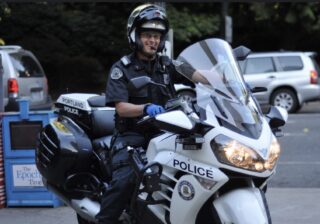
(Photo: J. Maus/BikePortland)
Everyone’s podcasting these days… including your local police officers.
The Portland Police Bureau launched a new podcast today. The ‘Talking Beat’ aims to provide, “Thoughtful conversations that… will inform and provide you with a small glimpse of the work performed by Portland police officers as well as issues affecting public safety in our city.” Among the first three episodes unveiled today included a discussion about transportation issues.
Traffic Division Sgt. Ty Engstrom and Ofc. Chris Johnson joined the host for a wide-ranging chat that included topics like distracted driving, visibility of walkers (or lack thereof), why people are allowed to speed without being cited, and more. (You might recall that Sgt. Engstrom was recently featured in our story about stop sign enforcement at Ladd Circle.)
Below are a few salient excerpts:
“Everybody’s driving over the speed limit. And so the majority of traffic officers give quite a bit of leeway when it comes to speeding.”
On people not being visible enough when outside of a car…
Host: I think people wear all black, they have the choice to wear all black, but then they dart across the street. And they may have the walk signal and they may have the right to wear all black, but the bottom line is, I can’t see you. So I guess you can be right, but you can also be dead right.
Ofc. Johnson:.. my feeling is pedestrians need to have a role of making themselves more visible because the driver as they’re driving, what they’re picking up on is going to be movement or some sort of visibility, being able to identify something out there in the road. And they’re scanning and sometimes the wipers are going, it’s raining, it’s dark. Sometimes the dash lights are there so they can’t see as well as a pedestrian often thinks they’re being seen.
On distracted driving…
Host: What’s the top worst behavior you see?
Sgt. Engstrom: I think there is quite a bit of distracted driving out there. Our current laws talk about electronic device use that is specifically prohibited. However, there’s a lot of other distractions out there. It’s not just those things. Maybe those are the ones that are specifically included in the laws… So I think distractions play a large role and then also speed. Many studies have gone to look at speed and that’s a high contributor to crashes. And if we reduce the speeds, the amount of safety that is a result of that is exponential.
Host: We focus on the texting and the talking on our phones, but I’ve seen people shaving, reading their paper, eating a hamburger. You can cite them for that too?
Sgt. Engstrom: Not under that particular law, but we have other laws that can take into account those types of behaviors. Careless driving is a pretty all-encompassing type of law where if they’re doing anything that can put other people in danger, then depending on the level of that danger and the level of their actions, it could either be a violation of careless driving or it can be a crime of reckless driving, which a crime they can actually go to jail for.
Advertisement
On vulnerable road users…
Host: We focus a lot on driving behavior, but there’s also the vulnerable road users. There’s bicyclists, there’s scooters, there’s pedestrians. And last year we had a significant number that were either injured or killed. They play a role as well. What can they do to stay safe?
Sgt. Engstrom: So anybody that’s not in a car, they’re not protected by that steel and metal all wrapped around them, and airbags and such. So they’re pretty vulnerable. I’m not going to say that it’s all the car’s fault, all the bicyclist’s fault, all the pedestrian’s fault. It’s everybody together. Everyone needs to take an effort and take a step towards making our roads more safe, and everyone needs to take their safety into their hands as well.
On officers’ discretion on when to cite…
Host: How do you decide whether to give a citation versus a warning?
Sgt. Engstrom: I can’t speak for all officers, but I will say that the majority of traffic officers probably feel the same way as me, that we give a lot of leeway. If we wanted to go out and write tickets for a five miles an hour over the speed limit, we could do that all day long. Everybody’s driving over the speed limit. And so the majority of traffic officers give quite a bit of leeway when it comes to speeding. I’m not going to say a specific number because I don’t want to give a magic number out to everybody and say, “Oh, it’s okay to go this fast because you’re not going to get a ticket.” But we give a lot of leeway. So if we stop you, that means you’ve pushed it real far.
And same thing with a lot of violations. Running red lights or things like that, I have a certain guideline for myself when the light turns red, where the position of the car is kind of a thing, and we give people a lot of leeway.
My goal is not to punish people and impact their lives and their livelihood with a bunch of fines and things like that.
What do you think? Full episode below:

You can learn more about the podcast on their website. If you have feedback or suggestions for future shows, call and leave a message at (971) 339-8868 or email talkingbeat@portlandoregon.gov.
— Jonathan Maus: (503) 706-8804, @jonathan_maus on Twitter and jonathan@bikeportland.org
Never miss a story. Sign-up for the daily BP Headlines email.
BikePortland needs your support.
